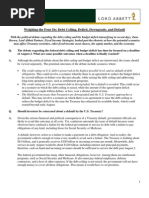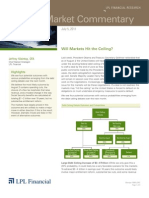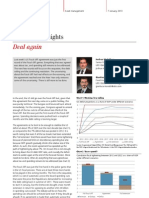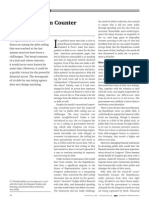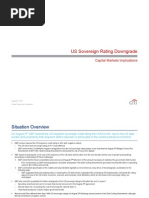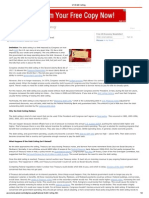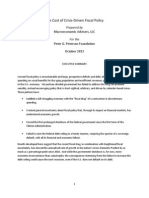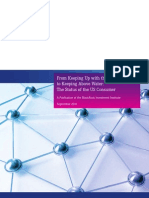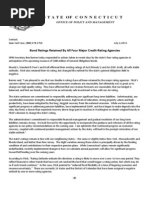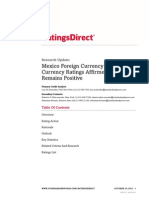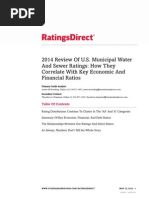The Debt Ceiling Debate Is Unlikely To Change The 'AA+' U.S. Sovereign Rating
The Debt Ceiling Debate Is Unlikely To Change The 'AA+' U.S. Sovereign Rating
Uploaded by
api-227433089Copyright:
Available Formats
The Debt Ceiling Debate Is Unlikely To Change The 'AA+' U.S. Sovereign Rating
The Debt Ceiling Debate Is Unlikely To Change The 'AA+' U.S. Sovereign Rating
Uploaded by
api-227433089Original Title
Copyright
Available Formats
Share this document
Did you find this document useful?
Is this content inappropriate?
Copyright:
Available Formats
The Debt Ceiling Debate Is Unlikely To Change The 'AA+' U.S. Sovereign Rating
The Debt Ceiling Debate Is Unlikely To Change The 'AA+' U.S. Sovereign Rating
Uploaded by
api-227433089Copyright:
Available Formats
Credit FAQ:
The Debt Ceiling Debate Is Unlikely To Change The 'AA+' U.S. Sovereign Rating
Primary Credit Analyst: Marie Cavanaugh, New York (1) 212-438-7343; marie.cavanaugh@standardandpoors.com Secondary Contact: John B Chambers, CFA, New York (1) 212-438-7344; john.chambers@standardandpoors.com
Table Of Contents
Frequently Asked Questions Related Criteria And Research
WWW.STANDARDANDPOORS.COM/RATINGSDIRECT
SEPTEMBER 30, 2013 1
1198193 | 301674531
Credit FAQ:
The Debt Ceiling Debate Is Unlikely To Change The 'AA+' U.S. Sovereign Rating
After the 2011 debt-ceiling impasse, Standard & Poor's Ratings Services lowered its long-term rating on the U.S. to 'AA+' from 'AAA'. This FAQ looks at the current debate in Washington and discusses its potential impact on the 'AA+/Stable/A-1+' issuer credit ratings we assign to the U.S. federal government.
Frequently Asked Questions
How might the politicking over the continuing resolution and the debt ceiling affect the U.S. sovereign rating?
In our opinion, the current impasse over the continuing resolution and the debt ceiling creates an atmosphere of uncertainty that could affect confidence, investment, and hiring in the U.S. However, as long as it is short-lived, we do not anticipate the impasse to lead to a change in the sovereign rating. This sort of political brinkmanship is the dominant reason the rating is no longer 'AAA.' Standard & Poor's sovereign rating on the U.S. is 'AA+' with a stable outlook, which according to our rating criteria indicates that we believe there is a less than 1-in-3 chance of a rating change over the next two years. We revised the outlook on the rating to stable from negative in June of this year, primarily in light of three factors: The ability of the branches of government to negotiate a compromise that lessened the impact of the so-called fiscal cliff; The decline in the annual general government budget deficit to half of its 2011 level, with projections of further declines through 2015 (10% of GDP in 2011, 4.9% in 2013, and 2.9% in 2015); and The strengthening economic recovery. These developments suggest to us the potential for further compromise and allow more time in deciding upon further fiscal adjustments. Also, most sovereigns find it easier to adjust when the economy is stronger.
What would the rating impact be if a continuing resolution does not pass in time to prevent a government shutdown?
If a continuing resolution does not pass, Standard & Poor's would estimate the likely economic impact, and its potential effect on the rating, when the parameters of a possible shutdown become clear. The government has not shut down since 1995-1996 when it shut for a total of 26 days. Because more appropriation bills had already passed before the shutdowns in 1995-1996 than is the case at present, the economic impact of a shutdown could be more significant now. Of course, the length of any shutdown is another important factor.
What would the rating impact be if the debt ceiling were not raised by the time net new financing is needed?
Failure to raise the debt ceiling is not in Standard & Poor's base-case assumptions. If the debt ceiling were not raised by the mid-October date, when the stop-gap measures employed in recent months are estimated to be exhausted, the
WWW.STANDARDANDPOORS.COM/RATINGSDIRECT
SEPTEMBER 30, 2013 2
1198193 | 301674531
Credit FAQ: The Debt Ceiling Debate Is Unlikely To Change The 'AA+' U.S. Sovereign Rating
U.S. would not be able to meet all of its obligations. Should the government fail to service a debt obligation, we would lower the sovereign rating to 'SD' (selective default). This designation indicates that the issuer, in this case the U.S. government, had failed to meet one or more of its outstanding debt obligations. The rating would remain at 'SD' until the default is cured, which may occur when delinquent principal and interest payments are paid in full. While each case is assessed on its own merits, from a historical perspective sovereign post-default ratings are generally between 'CCC+' and 'B.' However, other defaults by rated sovereigns have been the consequence of escalating political and economic pressures that compromised access to needed financing. None of these sovereign defaults have occurred because of political brinkmanship among branches of government. Standard & Poor's would analyze the changes in the political and economic landscape in determining a post-default rating.
Might other ratings be affected by the failure of the U.S. government to service its obligations on a timely basis?
Yes. We may lower our ratings on obligations that depend on payments by the U.S. government. Other ratings could be affected, depending upon the severity of the impact on financial markets, the payment and settlement systems, and the real economy, in the U.S. and possibly globally. It is difficult to ascertain the impact at this time, given the unprecedented nature of this event.
In the event of a sovereign default, how would Standard & Poor's expect the default to be cured?
Standard & Poor's expects holders of U.S. obligations in default to be paid in full and with interest, once a decision to raise the debt ceiling were reached. This should help to limit negative repercussions in the financial markets and the real economy, but it is difficult to estimate the dislocations that could occur in the interim. These dislocations would depend on a number of variables such as the duration of a default and the reaction of financial markets.
Does legislation prioritizing debt service, as recently passed by the House of Representatives, support the U.S. credit rating?
Fiscal rules (on debt service, debt, or deficits) do not, in and of themselves, affect ratings. Standard & Poor's has observed that such rules are often modified in periods of stress (for example, the constitution of Argentina that was in effect just prior to its last default prioritized debt service).
Does shutting down the government temporarily or delaying the increase in the debt ceiling result in a lower deficit?
By most estimates, no. Already authorized expenditures will have to be paid eventually. Additionally, any deficit reductions could be more than offset by the costs of developing contingency plans, identifying mandatory programs and essential personnel, and perhaps incurring certain fees and charges. Afterwards, interest rates may be higher and contractors may raise their bids to cover potential future delays in payment. In addition, we think the economy generally suffers because of uncertainty, even when an 11th hour agreement is reached, though the impact on the deficit is tough to measure.
What are the key supporting and constraining factors behind the U.S. sovereign rating?
The key supporting factors are: A diversified and resilient economy; Extensive monetary flexibility; The U.S. dollar's status as the world's premier reserve currency, which is the product of a variety of longstanding
WWW.STANDARDANDPOORS.COM/RATINGSDIRECT
SEPTEMBER 30, 2013 3
1198193 | 301674531
Credit FAQ: The Debt Ceiling Debate Is Unlikely To Change The 'AA+' U.S. Sovereign Rating
factors including political stability, respect for property rights and the rule of law, and success as a driver of innovation and global standards; and Willingness to use economic policy countercyclically and decisively, as seen in the 2008-2010 monetary and fiscal measures to bolster the U.S. financial sector and economy and support liquidity globally. The key constraining factors are: Political brinkmanship that has become more acrimonious in recent years, as seen in the current and 2011 debt ceiling debates, and an increasing reliance on continuing resolutions as a means of funding the federal government rather than budgeted annual appropriations; A budgetary process that separates spending and funding decisions, inhibits addressing the government's mediumand long-term fiscal challenges, and periodically puts predictability of debt service payments in question; and A high level of general government debt, and a medium-term fiscal profile in which, under most forecasts, does not see the level of government debt, as a share of the economy, stabilize. Longer-term challenges stem from demographics and the economic drag of deleveraging, while longer-term strengths include, in our view, innovation and rising energy production.
How has fiscal performance compared to expectations in 2011?
Net general government debt is higher than we anticipated in 2011 because of the upward revision of some regional and local government debt measures. General government annual budget deficits are trending lower than we anticipated two years ago because, in addition to the impact of the Budget Control Act of 2011 (passed on Aug. 2, 2011 and including sequestration among other measures), there have been: Cyclical improvements as the economy has strengthened; One-off improvements related to transfers of government supported entities profits and concern about a capital gains tax increase; and Permanent changes such as the end of the so-called "Bush tax cuts" for higher-income persons. Absent further fiscal measures, we expect deficits and debt to begin to rise as a percent of GDP in 2016.
By discussing the current impasse, isn't Standard & Poor's inserting itself in a political discussion?
Not at all. Just like any other commentary on the situation in Washington, our role is to assess and evaluate what is happening. An appraisal of the institutional and governance effectiveness of a country's political system is one of the five key elements of the criteria we use to rate sovereign governments. We see it as part of our mission to communicate our views on these and related matters of national importance that affect our credit analysis. We believe that the market benefits from more, rather than less, analysis about the factors influencing a government's willingness and ability to service its debt on time and in full.
Related Criteria And Research
United States of America, July 10, 2013 Sovereign Government Rating Methodology And Assumptions, June 24, 2013 United States of America 'AA+/A-1+' Ratings Affirmed; Outlook Revised To Stable On Receding Fiscal Risks, June
WWW.STANDARDANDPOORS.COM/RATINGSDIRECT
SEPTEMBER 30, 2013 4
1198193 | 301674531
Credit FAQ: The Debt Ceiling Debate Is Unlikely To Change The 'AA+' U.S. Sovereign Rating
10, 2013 United States of America Long-Term Rating Lowered To 'AA+' On Political Risks And Rising Debt Burden; Outlook Negative, Aug. 5, 2011 A Closer Look At The Revision Of The Outlook On The U.S. Government Rating, April, 18, 2011 Fiscal Challenges Weighing On The 'AAA' Sovereign Credit Rating On The Government Of The United States, April 18, 2011 Behind The Political Brinkmanship Of Raising The U.S. Debt Ceiling, Jan. 18, 2011 Aprs Le Dluge, The U.S. Dollar Remains The Key International Currency, March 10, 2010 The U.S. Debt Ceiling: As Headroom Shrinks, Its Time To Raise The Roof Beams, Oct. 9, 2009
WWW.STANDARDANDPOORS.COM/RATINGSDIRECT
SEPTEMBER 30, 2013 5
1198193 | 301674531
Copyright 2013 by Standard & Poor's Financial Services LLC. All rights reserved. No content (including ratings, credit-related analyses and data, valuations, model, software or other application or output therefrom) or any part thereof (Content) may be modified, reverse engineered, reproduced or distributed in any form by any means, or stored in a database or retrieval system, without the prior written permission of Standard & Poor's Financial Services LLC or its affiliates (collectively, S&P). The Content shall not be used for any unlawful or unauthorized purposes. S&P and any third-party providers, as well as their directors, officers, shareholders, employees or agents (collectively S&P Parties) do not guarantee the accuracy, completeness, timeliness or availability of the Content. S&P Parties are not responsible for any errors or omissions (negligent or otherwise), regardless of the cause, for the results obtained from the use of the Content, or for the security or maintenance of any data input by the user. The Content is provided on an "as is" basis. S&P PARTIES DISCLAIM ANY AND ALL EXPRESS OR IMPLIED WARRANTIES, INCLUDING, BUT NOT LIMITED TO, ANY WARRANTIES OF MERCHANTABILITY OR FITNESS FOR A PARTICULAR PURPOSE OR USE, FREEDOM FROM BUGS, SOFTWARE ERRORS OR DEFECTS, THAT THE CONTENT'S FUNCTIONING WILL BE UNINTERRUPTED, OR THAT THE CONTENT WILL OPERATE WITH ANY SOFTWARE OR HARDWARE CONFIGURATION. In no event shall S&P Parties be liable to any party for any direct, indirect, incidental, exemplary, compensatory, punitive, special or consequential damages, costs, expenses, legal fees, or losses (including, without limitation, lost income or lost profits and opportunity costs or losses caused by negligence) in connection with any use of the Content even if advised of the possibility of such damages. Credit-related and other analyses, including ratings, and statements in the Content are statements of opinion as of the date they are expressed and not statements of fact. S&P's opinions, analyses, and rating acknowledgment decisions (described below) are not recommendations to purchase, hold, or sell any securities or to make any investment decisions, and do not address the suitability of any security. S&P assumes no obligation to update the Content following publication in any form or format. The Content should not be relied on and is not a substitute for the skill, judgment and experience of the user, its management, employees, advisors and/or clients when making investment and other business decisions. S&P does not act as a fiduciary or an investment advisor except where registered as such. While S&P has obtained information from sources it believes to be reliable, S&P does not perform an audit and undertakes no duty of due diligence or independent verification of any information it receives. To the extent that regulatory authorities allow a rating agency to acknowledge in one jurisdiction a rating issued in another jurisdiction for certain regulatory purposes, S&P reserves the right to assign, withdraw, or suspend such acknowledgement at any time and in its sole discretion. S&P Parties disclaim any duty whatsoever arising out of the assignment, withdrawal, or suspension of an acknowledgment as well as any liability for any damage alleged to have been suffered on account thereof. S&P keeps certain activities of its business units separate from each other in order to preserve the independence and objectivity of their respective activities. As a result, certain business units of S&P may have information that is not available to other S&P business units. S&P has established policies and procedures to maintain the confidentiality of certain nonpublic information received in connection with each analytical process. S&P may receive compensation for its ratings and certain analyses, normally from issuers or underwriters of securities or from obligors. S&P reserves the right to disseminate its opinions and analyses. S&P's public ratings and analyses are made available on its Web sites, www.standardandpoors.com (free of charge), and www.ratingsdirect.com and www.globalcreditportal.com (subscription) and www.spcapitaliq.com (subscription) and may be distributed through other means, including via S&P publications and third-party redistributors. Additional information about our ratings fees is available at www.standardandpoors.com/usratingsfees.
WWW.STANDARDANDPOORS.COM/RATINGSDIRECT
SEPTEMBER 30, 2013 6
1198193 | 301674531
You might also like
- Grant's Interest Rate Observer X-Mas IssueDocument27 pagesGrant's Interest Rate Observer X-Mas IssueCanadianValueNo ratings yet
- Full Faith & Credit ActDocument6 pagesFull Faith & Credit ActRoy Tanner100% (12)
- US Downgraded AA+Document8 pagesUS Downgraded AA+Leigh ZeitzNo ratings yet
- U.S.-Style Fiscal Federalism Buffers State and Local Governments From Another Federal Shutdown - SomewhatDocument6 pagesU.S.-Style Fiscal Federalism Buffers State and Local Governments From Another Federal Shutdown - Somewhatapi-227433089No ratings yet
- Cutting Popular U.S. Tax Programs Could Harm Tax-Exempt Bond IssuersDocument8 pagesCutting Popular U.S. Tax Programs Could Harm Tax-Exempt Bond Issuersapi-227433089No ratings yet
- Brown Weighing The Four Ds 7-26-11Document7 pagesBrown Weighing The Four Ds 7-26-11Steve BobandericNo ratings yet
- Weekly Market Commentary 07-05-2011Document4 pagesWeekly Market Commentary 07-05-2011Jeremy A. MillerNo ratings yet
- Debt CeilingDocument4 pagesDebt Ceilingsam_cancerianNo ratings yet
- Illinois Rating Report, January 2013Document6 pagesIllinois Rating Report, January 2013Ann WeilerNo ratings yet
- Weekly Market Commentary 10/21/2013Document3 pagesWeekly Market Commentary 10/21/2013monarchadvisorygroupNo ratings yet
- California Deficit June2012Document12 pagesCalifornia Deficit June2012Alternative EconomicsNo ratings yet
- The Evolution of Government Support in U.S. Bank Ratings: Financial InstitutionsDocument10 pagesThe Evolution of Government Support in U.S. Bank Ratings: Financial Institutionsapi-227433089No ratings yet
- Sovereign Credit Ratings Primer - SPDocument24 pagesSovereign Credit Ratings Primer - SPRajiv TalariNo ratings yet
- The People United Will Leave The Banks DividedDocument4 pagesThe People United Will Leave The Banks DividedRicharnellia-RichieRichBattiest-CollinsNo ratings yet
- Global Risk Watch: No US Fiscal Cliff, But Beware The PotholeDocument17 pagesGlobal Risk Watch: No US Fiscal Cliff, But Beware The Potholeapi-157577146No ratings yet
- Holtzeakin Testimony 4oct2011Document12 pagesHoltzeakin Testimony 4oct2011Committee For a Responsible Federal BudgetNo ratings yet
- Fitch Downgrades IllinoisDocument4 pagesFitch Downgrades IllinoisAnn WeilerNo ratings yet
- 09.07.12 JPM Fiscal Cliff White PaperDocument16 pages09.07.12 JPM Fiscal Cliff White PaperRishi ShahNo ratings yet
- UBSeconomist-insights7 January2Document2 pagesUBSeconomist-insights7 January2buyanalystlondonNo ratings yet
- US DowngradeDocument4 pagesUS DowngradePavan KumarNo ratings yet
- An Update of The Dodd-Frank Act's Building Blocks Three Years LaterDocument15 pagesAn Update of The Dodd-Frank Act's Building Blocks Three Years Laterapi-227433089No ratings yet
- US Debt CeilingDocument4 pagesUS Debt CeilingHEYNo ratings yet
- Debt As Bargain CounterDocument2 pagesDebt As Bargain CounterGagandeep SinghNo ratings yet
- The Global Outlook Isn't Bad. But When Will It Be Good?Document6 pagesThe Global Outlook Isn't Bad. But When Will It Be Good?api-227433089No ratings yet
- Debt SustainabilityDocument6 pagesDebt SustainabilityyoussratiNo ratings yet
- A Bumpy Road Lies Ahead For U.S. Public Pension Funded LevelsDocument22 pagesA Bumpy Road Lies Ahead For U.S. Public Pension Funded Levelsapi-227433089No ratings yet
- Diagnosis and Treatment of Puerto Rico's Fiscal Crisis - VsenateDocument7 pagesDiagnosis and Treatment of Puerto Rico's Fiscal Crisis - VsenateAlfonso A. Orona AmiliviaNo ratings yet
- US Sovereign Rating Downgrade ImplicationsDocument13 pagesUS Sovereign Rating Downgrade ImplicationsBirgit UrsulaNo ratings yet
- 2011 11 22 China BridgewaterDocument12 pages2011 11 22 China Bridgewaternicholas.khuu492100% (3)
- Janney Fixed Income StrategyDocument7 pagesJanney Fixed Income StrategyJohn CortapassoNo ratings yet
- Understanding California's Fiscal Recovery: Primary Credit AnalystDocument6 pagesUnderstanding California's Fiscal Recovery: Primary Credit Analystapi-227433089No ratings yet
- Sovereigns: U.S. Public Finances - Overview and OutlookDocument15 pagesSovereigns: U.S. Public Finances - Overview and OutlookchanduNo ratings yet
- Federal DebtDocument14 pagesFederal Debtabhimehta90No ratings yet
- Municipal Bankruptcy: Standard & Poor's Approach and ViewpointDocument6 pagesMunicipal Bankruptcy: Standard & Poor's Approach and Viewpointapi-227433089No ratings yet
- Investment Insights - 30-03-2008 - Quantitative Easing and Buying Toxic DebtDocument3 pagesInvestment Insights - 30-03-2008 - Quantitative Easing and Buying Toxic DebtDemocracia real YANo ratings yet
- US Debt CeilingDocument2 pagesUS Debt CeilingmathiarasuNo ratings yet
- Credit rating(En)Document2 pagesCredit rating(En)leungNo ratings yet
- Physics 229 ReportDocument3 pagesPhysics 229 Reportwahyuandika2088No ratings yet
- Fiscal CliffDocument3 pagesFiscal CliffVikram RathodNo ratings yet
- 2012 Outlook - Us StatesDocument7 pages2012 Outlook - Us Statesm_zhangNo ratings yet
- Rating HistoriesDocument45 pagesRating HistoriesMatthew JensenNo ratings yet
- Crisis Driven Report FullreportDocument14 pagesCrisis Driven Report FullreportcaitlynharveyNo ratings yet
- Faces of Death: The US Dollar in CrisisDocument12 pagesFaces of Death: The US Dollar in CrisisRon HeraNo ratings yet
- The Markets Brace For The Washington Debt DebacleDocument8 pagesThe Markets Brace For The Washington Debt Debacleapi-227433089No ratings yet
- How Worried Should We Be If The Debt Ceiling Isn't Lifted DocxDocument4 pagesHow Worried Should We Be If The Debt Ceiling Isn't Lifted DocxiamshrimohanNo ratings yet
- Assignment - Credit PolicyDocument10 pagesAssignment - Credit PolicyNilesh VadherNo ratings yet
- SYZ & CO - SYZ Asset Management - Market Outlook 18 January 2013Document7 pagesSYZ & CO - SYZ Asset Management - Market Outlook 18 January 2013SYZBankNo ratings yet
- Black RockDocument8 pagesBlack RockesemangNo ratings yet
- Economist Insights 29 April4Document2 pagesEconomist Insights 29 April4buyanalystlondonNo ratings yet
- Muni Rally May Continue, But Must Navigate Policy RisksDocument3 pagesMuni Rally May Continue, But Must Navigate Policy RisksPutnam InvestmentsNo ratings yet
- Final Fitch MN GO Release 1 2Document3 pagesFinal Fitch MN GO Release 1 2Scott DibbleNo ratings yet
- Understanding The Int'l MacroeconomyDocument4 pagesUnderstanding The Int'l MacroeconomyNicolas ChengNo ratings yet
- Research PaperDocument11 pagesResearch Papertanyabhavsar15No ratings yet
- Statement On Rating Agencies ConnecticutDocument2 pagesStatement On Rating Agencies ConnecticutEditor, Hartford CourantNo ratings yet
- Responsible Approaches To Increasing The Debt Limit February 7, 2011Document4 pagesResponsible Approaches To Increasing The Debt Limit February 7, 2011Committee For a Responsible Federal BudgetNo ratings yet
- Finshastra October CirculationDocument50 pagesFinshastra October Circulationgupvaibhav100% (1)
- Public EconomicsDocument54 pagesPublic EconomicsManish KumarNo ratings yet
- Fitch Ratings ReportDocument3 pagesFitch Ratings ReportMaineHouseGOP2No ratings yet
- Mexico Foreign Currency and Local Currency Ratings Affirmed Outlook Remains PositiveDocument7 pagesMexico Foreign Currency and Local Currency Ratings Affirmed Outlook Remains Positiveapi-227433089No ratings yet
- Hidden Spending: The Politics of Federal Credit ProgramsFrom EverandHidden Spending: The Politics of Federal Credit ProgramsNo ratings yet
- Hooked On Hydrocarbons: How Susceptible Are Gulf Sovereigns To Concentration Risk?Document9 pagesHooked On Hydrocarbons: How Susceptible Are Gulf Sovereigns To Concentration Risk?api-227433089No ratings yet
- Japanese Corporates Hitch Growth Plans To Southeast Asian Infrastructure, But Face A Bumpy RideDocument14 pagesJapanese Corporates Hitch Growth Plans To Southeast Asian Infrastructure, But Face A Bumpy Rideapi-227433089No ratings yet
- Metropolitan Transportation Authority, New York Joint Criteria TransitDocument7 pagesMetropolitan Transportation Authority, New York Joint Criteria Transitapi-227433089No ratings yet
- How Is The Transition To An Exchange-Based Environment Affecting Health Insurers, Providers, and Consumers?Document5 pagesHow Is The Transition To An Exchange-Based Environment Affecting Health Insurers, Providers, and Consumers?api-227433089No ratings yet
- 2014 Review of U.S. Municipal Water and Sewer Ratings: How They Correlate With Key Economic and Financial RatiosDocument12 pages2014 Review of U.S. Municipal Water and Sewer Ratings: How They Correlate With Key Economic and Financial Ratiosapi-227433089No ratings yet
- Michigan Outlook Revised To Stable From Positive On Softening Revenues Series 2014A&B Bonds Rated 'AA-'Document3 pagesMichigan Outlook Revised To Stable From Positive On Softening Revenues Series 2014A&B Bonds Rated 'AA-'api-227433089No ratings yet
- Global Economic Outlook: Unfinished BusinessDocument22 pagesGlobal Economic Outlook: Unfinished Businessapi-227433089No ratings yet
- UntitledDocument16 pagesUntitledapi-227433089No ratings yet
- The Challenges of Medicaid Expansion Will Limit U.S. Health Insurers' Profitability in The Short TermDocument8 pagesThe Challenges of Medicaid Expansion Will Limit U.S. Health Insurers' Profitability in The Short Termapi-227433089No ratings yet
- Recent Investor Discussions: U.S. Consumer Products Ratings Should Remain Stable in 2014 Amid Improved Consumer SpendingDocument6 pagesRecent Investor Discussions: U.S. Consumer Products Ratings Should Remain Stable in 2014 Amid Improved Consumer Spendingapi-227433089No ratings yet
- Adding Skilled Labor To America's Melting Pot Would Heat Up U.S. Economic GrowthDocument17 pagesAdding Skilled Labor To America's Melting Pot Would Heat Up U.S. Economic Growthapi-227433089No ratings yet
- U.S. Corporate Flow of Funds in Fourth-Quarter 2013: Equity Valuations Surge As Capital Expenditures LagDocument12 pagesU.S. Corporate Flow of Funds in Fourth-Quarter 2013: Equity Valuations Surge As Capital Expenditures Lagapi-227433089No ratings yet
- New Jersey's GO Rating Lowered To A+' On Continuing Structural Imbalance Outlook StableDocument6 pagesNew Jersey's GO Rating Lowered To A+' On Continuing Structural Imbalance Outlook Stableapi-227433089No ratings yet
- The Media and Entertainment Outlook Brightens, But Regulatory Clouds GatherDocument17 pagesThe Media and Entertainment Outlook Brightens, But Regulatory Clouds Gatherapi-227433089No ratings yet
- French Life Insurers' Credited Rates To Policyholders For 2013 Indicate A Renewed Focus On Volume GrowthDocument5 pagesFrench Life Insurers' Credited Rates To Policyholders For 2013 Indicate A Renewed Focus On Volume Growthapi-227433089No ratings yet
- Inside Credit: Private-Equity Owners Lead The European IPO Resurgence As Company Valuations ImproveDocument11 pagesInside Credit: Private-Equity Owners Lead The European IPO Resurgence As Company Valuations Improveapi-227433089No ratings yet
- U.S. State and Local Government Credit Conditions Forecast: Waiting - . - and Waiting To ExhaleDocument17 pagesU.S. State and Local Government Credit Conditions Forecast: Waiting - . - and Waiting To Exhaleapi-227433089No ratings yet
- 10-22-15 EditionDocument32 pages10-22-15 EditionSan Mateo Daily JournalNo ratings yet
- Gonzales Cannon Jan. 17 IssueDocument22 pagesGonzales Cannon Jan. 17 IssueGonzales CannonNo ratings yet
- Pantheon Macroeconomics U.S. Economic Monitor, October 15Document5 pagesPantheon Macroeconomics U.S. Economic Monitor, October 15Pantheon MacroeconomicsNo ratings yet
- Boston Globe 2705Document32 pagesBoston Globe 2705CEI Geraldo Magela PeronNo ratings yet
- Spot BTC - The HumblingDocument7 pagesSpot BTC - The HumblingwutNo ratings yet
- The Washington Post 2011.04.20Document54 pagesThe Washington Post 2011.04.20Ник ЧенNo ratings yet
- Oct13a Evening ShutdownDocument12 pagesOct13a Evening ShutdownCBS_NewsNo ratings yet
- Dodge Construction Outlook 2014Document5 pagesDodge Construction Outlook 2014Erik HooverNo ratings yet
- Notice: Agency Information Collection Activities Proposals, Submissions, and ApprovalsDocument2 pagesNotice: Agency Information Collection Activities Proposals, Submissions, and ApprovalsJustia.comNo ratings yet
- CRS Debt CeilingDocument39 pagesCRS Debt CeilingStephen LoiaconiNo ratings yet
- US Debt Crisis Presentation v1.1Document28 pagesUS Debt Crisis Presentation v1.1Mythri MacherlaNo ratings yet
- Treasury Letter To Congress 100115Document2 pagesTreasury Letter To Congress 100115Brett LoGiuratoNo ratings yet
- Case Presentation-McKenzie Corporations Capital BudgetingDocument17 pagesCase Presentation-McKenzie Corporations Capital Budgetingpragati bora75% (4)
- PJM 2018 Load Forecast ReportDocument104 pagesPJM 2018 Load Forecast ReportEric ButterNo ratings yet
- Mahatma Gandhi National Rural Employment Guarantee ProgramDocument28 pagesMahatma Gandhi National Rural Employment Guarantee Programabhis04No ratings yet
- The Bridge, March 1, 2012Document28 pagesThe Bridge, March 1, 2012The BridgeNo ratings yet
- 10-02-13 EditionDocument32 pages10-02-13 EditionSan Mateo Daily JournalNo ratings yet
- Barclays Global Macro Apr 24Document13 pagesBarclays Global Macro Apr 24Hank DayNo ratings yet
- Public Debt Myths and RealitiesDocument22 pagesPublic Debt Myths and Realitiestymoignee100% (1)
- US Debt CeilingDocument4 pagesUS Debt CeilingHEYNo ratings yet
- MC 0728Document16 pagesMC 0728mcchronicleNo ratings yet
- Smart InvestmentDocument82 pagesSmart InvestmentJitesh KattaNo ratings yet
- Full Faith and Credit Act Authenticated PDFDocument4 pagesFull Faith and Credit Act Authenticated PDFLexu100% (5)
- Print BUS 100 - QuizletDocument20 pagesPrint BUS 100 - QuizletMac TorejaNo ratings yet
- Caribbean GraphicDocument20 pagesCaribbean GraphicCaribbeanGraphicNo ratings yet
- Emergency Budget 2020/2021: o e Er e Can Recover S RongerDocument34 pagesEmergency Budget 2020/2021: o e Er e Can Recover S RongerGeorge WoodNo ratings yet
- Debt Limit Scenario UpdateDocument14 pagesDebt Limit Scenario UpdateJonathan AllenNo ratings yet





